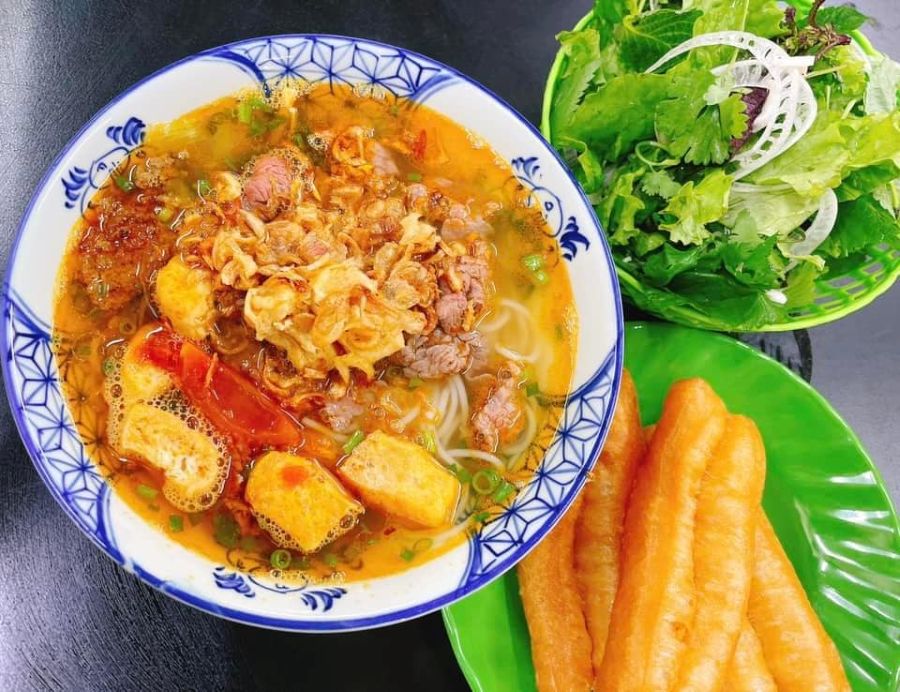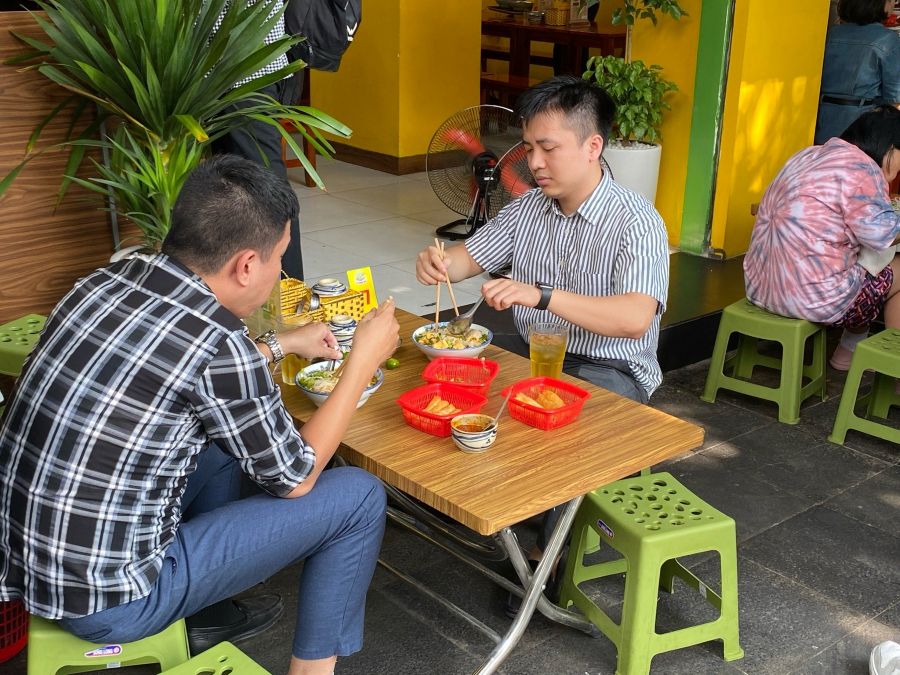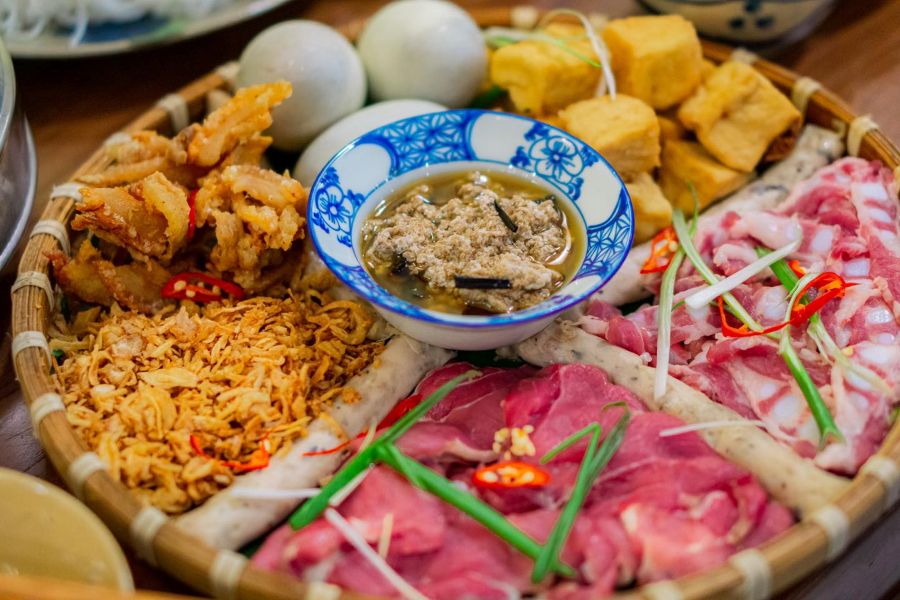Authentic Hanoi Old Quarter bun rieu: Irresistible charm
In Hanoi's Old Quarter in the Hoan Kiem district, simple yet delicious Hanoi street food wins the hearts of foreign visitors.
Although bun rieu is a common dish in Vietnam, Hanoi's Old Quarter serves one that is arguably the best.
| Hanoi Old Quarter's bun rieu is appealing both in taste and appearance. Photo: Ngo Thu Trang |
In the heart of the capital, a bowl of bun rieu or hot vermicelli soup with rice field crab is visually appealing, aromatic, and delicious, featuring yellow-brown crab fat, and bright red tomato interspersed with white vermicelli. The dish's unique flavors of freshwater crab, aromatic boiling tomalley, and slightly sour broth are readily identifiable to diners.
Hanoians are known for being fussy eaters - every dish has to be both tasty and authentic. A typical example is bun rieu, which has its own style of preparation. The main ingredient, crabs, is rigorously selected by Hanoi chefs.
They must be delicious freshwater crabs - with shiny, large, dark gray shells, no lost limbs, and strong claws that always point upward. Their ventral plates, or "aprons," must not bubble or bend when pressed. Male crabs with narrow aprons provide more meat, while female crabs with wide aprons offer more tomalley or fat.
| Today, bun rieu includes beef shank, head cheese, and gristle ribs, depending on the diner's preference. Photo: Cong Vu |
The selected crabs are then washed, thoroughly ground, and soaked in water. The broth is then boiled over low heat with a little salt, stirring constantly in a circular motion so that the meat doesn't stick to the bottom of the pot and burn. When the meat floats, it is removed and placed in a separate bowl.
Simmering the crab fat is an equally important step in making the dish. Dried shallots are sliced and fried until fragrant, then the tomalley is added to the pan and simmered over a reduced heat. A little annatto oil is also added to add color and flavor. Next, the fat over the crab meat is skimmed off. The pan is rinsed - the water is not wasted but added to the broth to enhance its flavor.
| Hanoi diners enjoy their aesthetically pleasing bowls of bun rieu while sitting on plastic seats on the sidewalk. Photo: Bun Rieu Co Huong Beo |
An essential condiment for bun rieu, good quality concentrated vinegar gives the broth its delicate acidic flavor. Simmered chili is another essential ingredient. After frying dried shallots in lard, the heat is lowered to the lowest setting. Chili powder is then added and boiled, and the mixture is seasoned to taste with a pinch of salt.
However, bun rieu wouldn't be so celebrated without the tomatoes, which are divided into two portions: the first is sliced like orange slices, and the second includes chopped pieces. After frying the dried shallots, the chopped tomatoes are stir-fried, sieved, and added to the crab broth to color it. The first portion of tomatoes is also cooked for a few minutes, seasoned to taste, and then slowly put into the broth to have acidity and color.
| Raw vegetables are an essential accompaniment to a bowl of bun rieu. Photo: Bun Rieu Co Huong Beo |
When the dish is served, an adequate amount of thin rice noodles is placed in a bowl, accompanied by a scoop of crab meat and fat, simmered chili, and chopped green onion. Finally, scalding hot broth is poured over everything. When eating, diners can add a little shrimp paste for flavor and a sweet aftertaste.
In addition, a traditional Hanoi bun rieu would be incomplete without a side of raw vegetables. In the past, Hanoians used chopped corn salad, but now it has been replaced by lettuce. Other vegetables such as marjoram, Vietnamese coriander, coriander, Vietnamese basil, bean sprouts, or shredded banana blossoms are mixed and eaten with the main dish.
In "Hanoi’s Delicacies," the late author Vu Bang wrote: "Glossy rice noodles, with hot crab meat on top, glistening purple crab fat with tiny golden dots amid a few pieces of red tomato; then a little shrimp paste is added, eaten with shredded young lettuce that looks like green threads... It is an ancient snack, you can say it is rustic, but I challenge anyone to see a flat basket of bun rieu offered by a vendor with rising steam and not crave it...".
| Lau rieu cua or crab hotpot, a more luxurious version of bun rieu. Photo: Bun Rieu Co Huong Beo |
That's how old-style bun rieu is described. Today in Hanoi, the dish is tweaked with more ingredients, such as rare fried beef shank, head cheese, gristle ribs, fried tofu, or snails.
Although it is now easy to find bun rieu in the city, the best versions are made by shoulder-strap vendors in the Old Town. Their customers sit on plastic stools, holding steaming bowls, inhaling the rich aroma of crab mixed with shrimp paste, munching on soft crab meat and crispy tofu, eating and leisurely admiring the streets of Hanoi. An indescribably pleasant feeling that you will remember forever.
Visitors to Hanoi can sample some of the bun rieu Eateries in Hanoi’s Old Quarter as listed below:
- * Bun Rieu Co Dung (Ms. Dung’s Bun Rieu), No.18 Nguyen Sieu Str., Hoan Kiem District
- * Bun Rieu Ba Diec or Mrs Deaf’ Bun Rieu, No. 68 Nguyen Thiep Str., Hoan Kiem District
- * Bun Rieu Oc Co Minh (Ms. Minh’s Hot Vermicelli Soup with Rice-field Crab & Snail), No.42 Ly Thuong Kiet Str., Hoan Kiem District
- * Bun Rieu Co Hoan, No. 16 Hang Luc Str., Hoan Kiem District
- * Bun Rieu Co Huong Beo or Ms. Huong Beo (fat Huong), No. 68 Hai Ba Trung Str., Hoan Kiem District
















